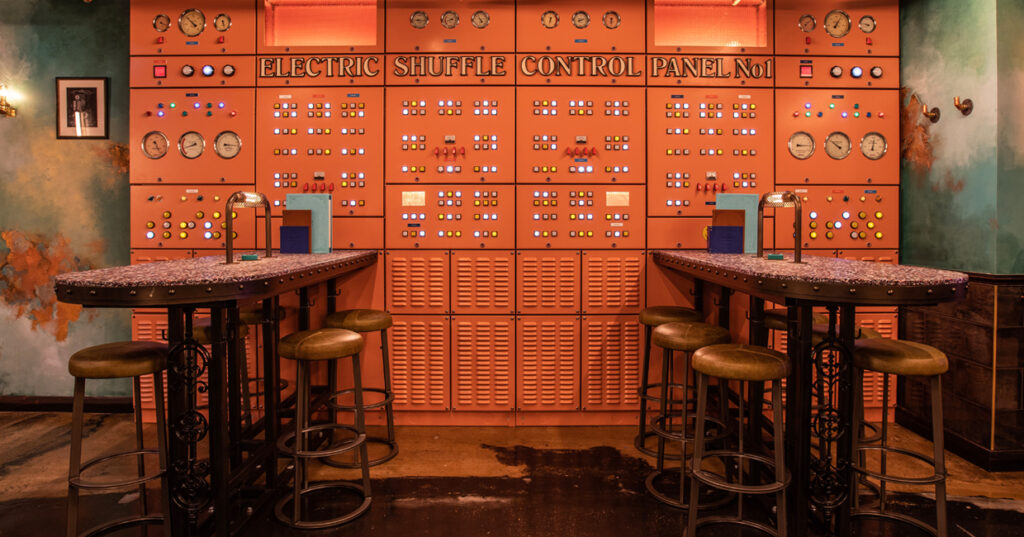Electric Shuffle has reinvented the classic game of shuffleboard for the 21st century, bringing an experiential reimagining of this vintage game to Canary Wharf.
Ellis Design Studio was commissioned by the designers behind Flight Club to deliver a beautifully designed, conceptual space within the 9,000 square foot, two storey venue.
As part of the brief, the game of shuffleboard has been redesigned and ‘electrified’. Ellis Design Studio drew inspiration from the pioneers of electrical technology, in particular the work of Nikola Tesla – an inventor, electrical engineer and futurist whose designs revolutionised the use of electricity.
“Ellis Design Studio drew inspiration from the pioneers of electrical technology, in particular the work of Nikola Tesla”
“The spirit of the design has been forged from these diverse influences producing a scheme which is vibrant, contemporary, unique and electric,” explains Alan Ellis, MD at Ellis Design Studio. “The fusion of these ideas manifested in a design scheme we describe as the ‘beautiful factory’. The idea is to celebrate the beauty in utility and reimagine and celebrate the industrial/Deco inspired aesthetic with a nod to the genius of Tesla.”
The essence of the interior design is a blend of both the glamour of the Art Deco period of 1940s Palm Springs, fused with the grandeur and faded elegance of early 20th century power plants and factories. The factory-inspired aesthetic is both utilitarian and industrial, yet implicitly beautiful and works as a perfect counterpoint to the opulence of the Deco inspired elements.
The striking shuffleboard tables have been completely re-envisioned by the Studio to form a central focus as social hubs within the scheme. The tables feature a high gloss custom inlaid timber surface, manufactured in the United States specifically for Electric Shuffle.
The table design is inspired by the aesthetic of the grand ocean liners, on which the game had its original heyday. Curvilinear forms in the timber and decorative copper pipework reinforce the aesthetic along with inlaid copper details, leather upholstered detailing and laser cut metal elements, which bring together a mix of classic and contemporary, Art Deco and industrial.
“The essence of the interior design is a blend of both the glamour of the Art Deco period of 1940s Palm Springs, fused with the grandeur and faded elegance of early 20th century power plants and factories”
The main bar on the ground floor, meanwhile, is a dramatic double height, power plant-inspired design and pays homage to both the 1940’s factory aesthetic and the early designs of electrical transmission experiments.
A large central bespoke rotating light feature, which dominates the centre of the double height void space at the main bar, is suggestive of an electrical turbine while copper-accented fluted timber detailing creates the illusion of innumerable copper tubes conducting wiring to ‘power’ the venue.
The back bar features an intricately tiled arch, which is inspired by vintage power plant aesthetic, combined with curvilinear, Deco inspired forms. The custom printed wallpaper used at high level evokes a sense of movement and lustre here; its pattern suggestive of patinated, rusted metals and the beauty of polychromatic swirling oil slicks.
The first-floor bar features a contemporary re-interpretation of utilitarian metal factory panelling rendered in vivid electric blue, which has been overlaid with embellished meshes and bespoke bronze domes, in a pattern reminiscent of electrical circuitry.
The studio has commissioned artisan ceramicists to create oversized decorative domed ‘rivet’ features and bespoke mid-century inspired lighting for the columns which flank the bar.
Freestanding tables were crafted bespoke for the space, and incorporate custom designed brass tabletop lighting and a recycled composite plastic tabletop material from Smile Plastics.
The recalibrated beauty of a faded and distressed aesthetic has been echoed in the hand painted scenic effects to the walls throughout the venue. The approach for this element of the design was inspired by the colours and textures found in rusted and patinated metals, for the ground floor spaces, and the unexpected delicate beauty of mould blooms and the faded striations of watermarks, for the first-floor walls.
Each and every component of the interior scheme has been carefully considered the studio, reinforcing that unique fusion of early power station and factory design and the lustre of the Art Deco era.



